 |
NEWS: January 28, 2008
Bird’s Eye View of the News
Atila Sinke Guimarães
JESUITS: HIGH OR LOW SPEED? - The 35th General Congregation of the Jesuits (GC-35) is taking place in Rome these days: it started January 14 and can take several months to end – no definite date. From the time St. Ignatius founded the Society of Jesus in 1534, 474 years ago, only 35 general meetings have been called: 29 ordinary ones to elect the next generals, 6 for extraordinary reasons. Since the Jesuits are in a certain sense the most important and numerous of the Catholic Religious Orders, it is worthwhile analyzing it to understand the ensemble.
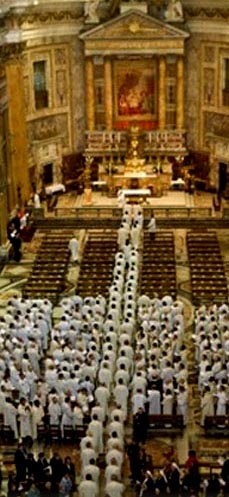
Jesuit delegates to GC-35
at the Church of Gesu |
This GC-35 was convened to accept the resignation of its superior general Fr. Peter-Hans Kolvenbach and to elect a new head for the Order. The 217 delegates of Jesuit provinces around the world will also make decisions on a long agenda of themes.
Theology of Liberation
Fr. Kolvenbach was elected in September 1983 to replace Fr. Pedro Arrupe, who suffered a stroke in 1981 and became increasingly incapable of governing. Fr. Arrupe had completely changed the face of the Society of Jesus to adapt it to the new winds of Vatican II. He made the Society a frontrunner in promoting social and political issues in order “to bring justice” for the poor and “liberate” them from the "structures of sin" (Capitalism) in Third World countries.
Significant expressions of this new approach were:
- The political action of the Jesuits of Bellarmine Center in Chile that prepared the way for the Marxist Salvador Allende to become President of the country (1970-1973);
- The participation of Jesuit Fr. Ernesto Cardenal in the Sandinist National Liberation Front [FSLN] which took power in Nicaragua (1979). Cardenal became the Minister of Culture in the new Communist government.
Although Kolvenbach was less ostentatious than Arrupe regarding social issues, this general line did not change substantially under his term. Even if the speed of their revolutionary initiatives diminished, Jesuits kept instigating or participating in the same social-political fights.
Consider, for example, the close involvement of Jesuit professors at the University of El Salvador in the Communist FMLN (Farabundo Marti National Liberation Front). In the late ‘80s FMLN, with Jesuit orientation, managed to conquer one-fourth of El Salvador, which was immersed in a civil war. A retaliation from the other side caused six of them to be killed (1989).
More recently (2007) Fr. Jon Sobrino, SJ, also a professor at the University of El Salvador, received a condemnation from the Vatican for preaching the same Theology of Liberation championed by FMLN.
Buddhism and Hinduism
For quite some time the Society of Jesus has been a promoter of Buddhism. Such support became apparent with the landmark books of Fr. Henri de Lubac, Aspects of Buddhism, [1951] and La Recontre du Bouddhisme et de l’Occident [The Meeting of Buddhism and the West, 1952]. De Lubac gave a special emphasis to the Japanese Amida Buddhism and wrote another book entitled simply Amida, published in 1955.
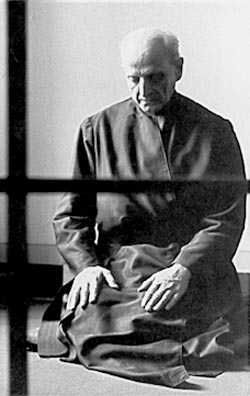
General Fr. Arrupe adopts a Buddhist position for his meditation |
Now then, before his election Fr. Arrupe had been a priest in Japan for a long time and assimilated many customs of Buddhism there. Even after becoming the General of the Jesuits, it was common to find him pictured in photos barefoot and seated cross-legged in Buddhist meditation.
Again, this direction didn’t change under Fr. Kolvenbach, who was also Buddhism-oriented. In the 25 years of his term, the Jesuits were allowed or even encouraged to mix Buddhism with Catholicism. I offer two examples that came to public attention:
- Fr. Anthony de Mello, who was born and lived in India, taught a kind of mystical syncretism between Catholicism, Buddhism and Hinduism. There is no indication that he was ever censured by Fr. Kolvenbach. In 1998 the Vatican made a posthumous condemnation of de Mello’s works. Shortly after, however, the censure was lifted and changed into a simple warning.
- Fr. Jacques Dupuis, a Belgian who also lived and taught in India, wrote many works proposing the assimilation of Buddhist and Hinduist principles into the Catholic Faith. He was invited by the heads of the Society of Jesus to teach in the Gregorian University in Rome and became director of its prestigious magazine Gregorianum. He was then invited by the Vatican to be a consultor at the Pontifical Council for Interreligious Dialogue. After all this, one of his works was placed under suspicion. But in the end, there were no practical consequences. John Paul II shortly would praise him publicly for his “pioneering” work, and lay any lingering suspicion to rest.
So, even though Kolvenbach had a more bureaucratic style without any special charisma of leadership, he followed the same general lines drawn by Arrupe. As noted above, at most what he did was to change Arrupe’s speed to slow motion.
Why did Kolvenbach step down?
Fr. Kolvenbach was the first Jesuit General to voluntarily present his resignation, since the Generals are elected for life. The resignation of Fr. Arrupe was supposed (or imposed) since after his stroke in 1981, he had become completely mute. Kolvenbach alleged his age – he will soon be 80 – as the reason for his retirement.
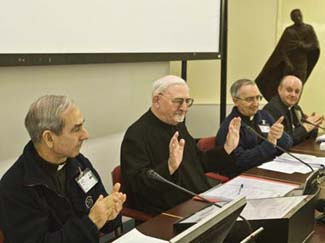
Kolvenbach, hands up, sets a precedent by stepping down |
It would seem that this initiative is intended to set a precedent for future Generals, and also to pressure Benedict XVI to do the same. However, Pope Ratzinger, who approved the agenda of GC-35 before the meeting, removed this point from discussion, precisely to prevent any such suggestion. “He was alarmed by the thought that if the ‘black pope’ was obliged to retire, people might start to expect the same from the ‘white pope,’” observed the London-based The Tablet (January 5, 2008, p. 6). It seems that Ratzinger, who in the past had commented that JPII should retire because of his age, is enjoying the taste of power …
I’m not sure whether age was, in fact, the only reason for Kolvenbach to retire given that before delivering his last speech, he jokingly thanked the delegates for “the elegant way you have found to fire me” (January 14, 2008, Updates from Rome, www.Jesuit.org). Anyway, Kolvenbach was “fired” and Fr. Adolfo Nicolás was elected on January 19.
Symptoms of the future
Fr. Nicolás, age 71, was born in Spain and, like Fr. Arrupe, he spent a great part of his priestly life in Japan. Nicolás was Provincial of the Jesuits in Japan and then President of the Jesuit Conference of East Asia. He went to Rome as the theological adviser for Japanese Bishops attending the Bishops’ Synod of Asia. Some Vatican officials were surprised during the synod when the Japanese Bishops urged the Vatican to demonstrate greater respect for their knowledge of their local languages and cultures in the translations of liturgical texts and adaptation of liturgical prayers to local culture –inculturation. When in 1998, the name of Fr. Nicolás was proposed to be the rector of the Pontifical Gregorian University, it was duly vetoed by the Vatican because of his action at the synod.
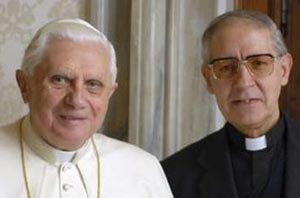
Benedict XVI with Nicolas on January 26 |
On Sunday, January 20, Fr. Nicolás said the Mass and delivered a short sermon, his first public statement as General of the Jesuits. In it we find a great emphasis in helping “the poor, the marginalized, and the excluded.”
Although he showed no sympathy for political involvements, he indirectly touched the general line of Liberation Theology when he stated:
“In this globalized world of ours the number of those excluded by all is increasing. Those excluded are diminished, since our society only has room for the big and not the small. All those who are disadvantaged, manipulated, all of these, may perhaps be for us the ‘nations.’ The nations that need the prophetic message of God.”
These words seem to echo the tones and emphasis given by Fr. Arrupe in bringing “justice” to the poor and marginalized.
Regarding inter-religious dialogue, it is significant that he does not believe that the Catholic Church is the only way to salvation. Indeed, he affirmed:
“Our God, our faith, our message, and our health are so great that they cannot be enclosed within a container, in any group or community, regardless whether or not the group in question happens to be a religious community.”
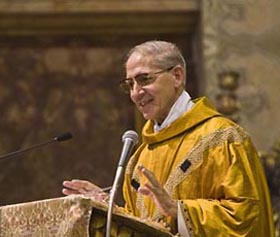
Will Nicolas move the Jesuits at the fast or slow pace? |
Then, he alluded to Buddhists and Hinduists:
“The others are our collaborators, if they share our same perspective, if they have the same heart Christ has given us. And if they have a bigger heart and an even greater vision, then we are their collaborators” (January 20, 2008, CG-35 Updates from Rome, www.Jesuit.org).
These are the two main lines of his speech that fit well with the past of the Society of Jesus.
I think that with the election of Fr. Alfonso Nicolás there has been no volte-face; rather it confirms the same progressivist path the Jesuits have taken since Fr. Arrupe. The only point to watch is the speed: Will his Spanish blood bring a return to the high speed pace in Liberation Theology and “inculturation” with Buddhism and Hinduism? Or will it continue along the slower and more prudent track of Kolvenbach? Time will tell. Let’s wait and see.


Related Topics of Interest
 Buddhism Promoted at Jesuit Loyola University Buddhism Promoted at Jesuit Loyola University
 Jesuit Performs Hindu Liturgical Dance Jesuit Performs Hindu Liturgical Dance
 Jesuit University Hosts Drag Show Jesuit University Hosts Drag Show
 Jesuits Defend Ordination for Homosexuals Jesuits Defend Ordination for Homosexuals
 Liberation Ecology Liberation Ecology
 La Civiltà Cattolica: Vatican II Closed the Trent Era La Civiltà Cattolica: Vatican II Closed the Trent Era
 Jesuit Director of Mother Teresa Is a Pedophile Jesuit Director of Mother Teresa Is a Pedophile


|
News | Home | Books | CDs | Search | Contact Us | Donate

©2002- Tradition in Action, Inc. All Rights Reserved
|
 |
|